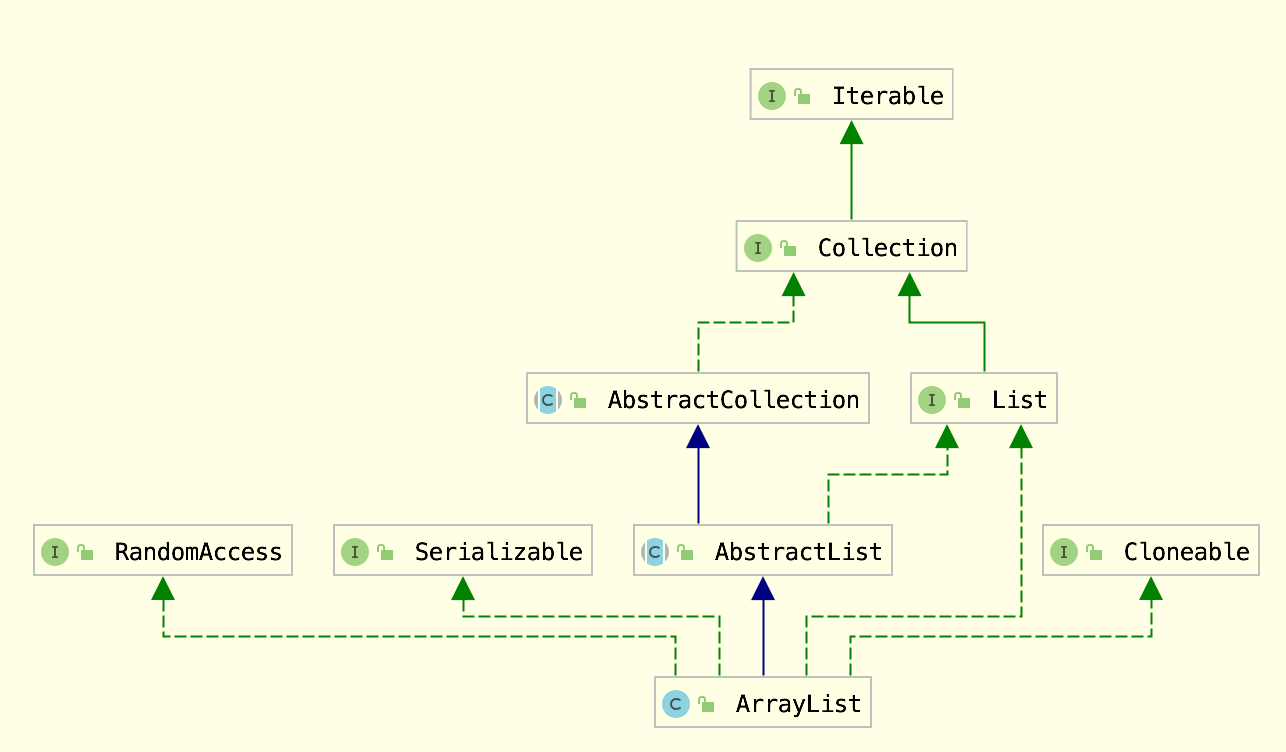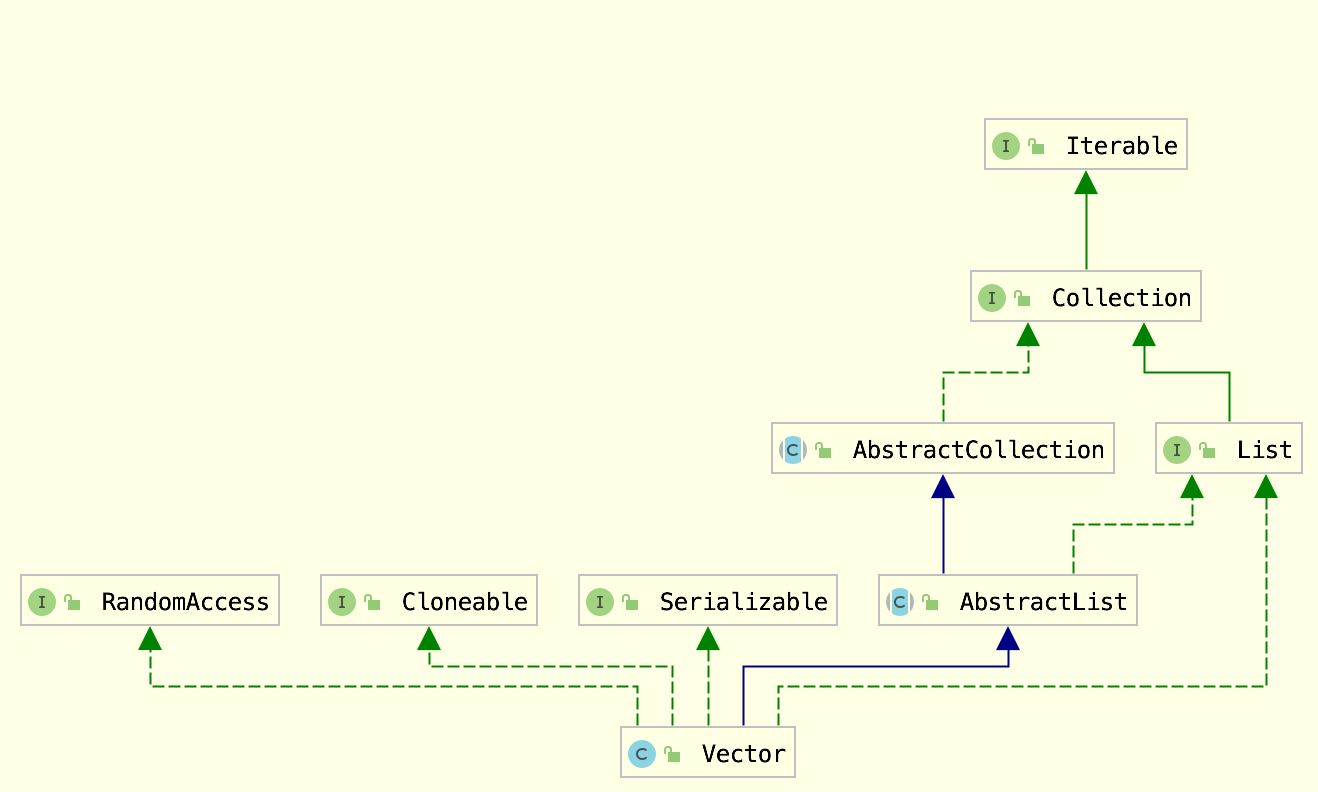ArrayList
ArrayList 实现于 List、RandomAccess 接口。可以插入空数据,也支持随机访问。
类图:

ArrayList相当于动态数据,其中最重要的两个属性分别是: elementData 数组,以及 size 大小。
/**
* Default initial capacity.
*/
private static final int DEFAULT_CAPACITY = 10;
transient Object[] elementData; // non-private to simplify nested class access
/**
* The size of the ArrayList (the number of elements it contains).
*/
private int size;
add(e)
通过add(e)方法向数组尾部添加数据
public boolean add(E e) {
ensureCapacityInternal(size + 1); // Increments modCount!!
elementData[size++] = e;
return true;
}
这个方法做了下面事情:
- 首先进行扩容校验
- 将插入的值放到尾部,并将 size + 1
add(index,e)
通过add(index,e) 在指定位置添加的话
public void add(int index, E element) {
rangeCheckForAdd(index);
ensureCapacityInternal(size + 1); // Increments modCount!!
System.arraycopy(elementData, index, elementData, index + 1,
size - index);
elementData[index] = element;
size++;
}
这个方法也是首先扩容校验。
接着对数据进行复制,目的是把 index 位置空出来放本次插入的数据,并将后面的数据向后移动一个位置。
扩容
扩容最终调用的代码
private void grow(int minCapacity) {
// overflow-conscious code
int oldCapacity = elementData.length;
int newCapacity = oldCapacity + (oldCapacity >> 1); //newCapacity计算逻辑
if (newCapacity - minCapacity < 0)
newCapacity = minCapacity;
if (newCapacity - MAX_ARRAY_SIZE > 0)
newCapacity = hugeCapacity(minCapacity);
// minCapacity is usually close to size, so this is a win:
elementData = Arrays.copyOf(elementData, newCapacity);
}
也是一个数组复制的过程。
由此可见 ArrayList 的主要消耗是数组扩容以及在指定位置添加数据。
在日常使用时最好是指定大小,尽量减少扩容。更要减少在指定位置插入数据的操作。
序列化
由于 ArrayList 是基于动态数组实现的,所以并不是所有的空间都被使用。因此使用了 transient 修饰,可以防止被自动序列化。
transient Object[] elementData; // non-private to simplify nested class access
ArrayList 自定义了序列化与反序列化:
/**
* Save the state of the <tt>ArrayList</tt> instance to a stream (that
* is, serialize it).
*/
private void writeObject(java.io.ObjectOutputStream s)
throws java.io.IOException{
// Write out element count, and any hidden stuff
int expectedModCount = modCount;
s.defaultWriteObject();
// Write out size as capacity for behavioural compatibility with clone()
s.writeInt(size);
// Write out all elements in the proper order.
for (int i=0; i<size; i++) {
s.writeObject(elementData[i]);
}
if (modCount != expectedModCount) {
throw new ConcurrentModificationException();
}
}
/**
* Reconstitute the <tt>ArrayList</tt> instance from a stream (that is,
* deserialize it).
*/
private void readObject(java.io.ObjectInputStream s)
throws java.io.IOException, ClassNotFoundException {
elementData = EMPTY_ELEMENTDATA;
// Read in size, and any hidden stuff
s.defaultReadObject();
// Read in capacity
s.readInt(); // ignored
if (size > 0) {
// be like clone(), allocate array based upon size not capacity
ensureCapacityInternal(size);
Object[] a = elementData;
// Read in all elements in the proper order.
for (int i=0; i<size; i++) {
a[i] = s.readObject();
}
}
}
jvm序列化机制:
当对象中自定义了 writeObject 和 readObject 方法时,JVM 会调用这两个自定义方法来实现序列化与反序列化。
从实现可以看出 ArrayList 只序列化了被使用的数据。
查询
public E get(int index) {
rangeCheck(index);
return elementData(index);
}
E elementData(int index) {
return (E) elementData[index];
}
直接获取数组下标的对应元素,效率很高!
Vector
Vector 也是实现于 List 接口,底层数据结构和 ArrayList 类似,也是一个动态数组存放数据。

不过是在 add() 方法的时候使用 synchronized 进行同步写数据,但是开销较大,所以 Vector 是一个同步容器并不是一个并发容器。因此Vector并不常用!
add(e)
/**
* Appends the specified element to the end of this Vector.
*/
public synchronized boolean add(E e) {
modCount++;
ensureCapacityHelper(elementCount + 1);
elementData[elementCount++] = e;
return true;
}
add(index,e)
public void add(int index, E element) {
insertElementAt(element, index);
}
/**
* Inserts the specified object as a component in this vector at the
* specified {@code index}.
*/
public synchronized void insertElementAt(E obj, int index) {
modCount++;
if (index > elementCount) {
throw new ArrayIndexOutOfBoundsException(index
+ " > " + elementCount);
}
ensureCapacityHelper(elementCount + 1);
System.arraycopy(elementData, index, elementData, index + 1, elementCount - index);
elementData[index] = obj;
elementCount++;
}